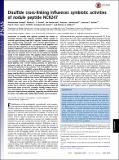Disulfide cross-linking influences symbiotic activities of nodule peptide NCR247
Author(s)
Price, Paul A.; Griffitts, Joel S.; Shabab, Mohammed; Penterman, Jon; Bocker, Hartmut Thomas; Wommack, Andrew; Nolan, Elizabeth Marie; Arnold, Markus F. F.; Walker, Graham C.; ... Show more Show less
Download10157.full.pdf (746.7Kb)
PUBLISHER_POLICY
Publisher Policy
Article is made available in accordance with the publisher's policy and may be subject to US copyright law. Please refer to the publisher's site for terms of use.
Terms of use
Metadata
Show full item recordAbstract
Interactions of rhizobia with legumes establish the chronic intracellular infection that underlies symbiosis. Within nodules of inverted repeat-lacking clade (IRLC) legumes, rhizobia differentiate into nitrogen-fixing bacteroids. This terminal differentiation is driven by host nodule-specific cysteine-rich (NCR) peptides that orchestrate the adaptation of free-living bacteria into intracellular residents. Medicago truncatula encodes a family of > 700 NCR peptides that have conserved cysteine motifs. NCR247 is a cationic peptide with four cysteines that can form two intramolecular disulfide bonds in the oxidized forms. This peptide affects Sinorhizobium meliloti transcription, translation, and cell division at low concentrations and is antimicrobial at higher concentrations. By preparing the three possible disulfide-cross-linked NCR247 regioisomers, the reduced peptide, and a variant lacking cysteines, we performed a systematic study of the effects of intramolecular disulfide crosslinking and cysteines on the activities of an NCR peptide. The relative activities of the five NCR247 variants differed strikingly among the various bioassays, suggesting that the NCR peptide-based language used by plants to control the development of their bacterial partners during symbiosis is even greater than previously recognized. These patterns indicate that certain NCR bioactivities require cysteines whereas others do not. The results also suggest that NCR247 may exert some of its effects within the cell envelope whereas other activities occur in the cytoplasm. BacA, a membrane protein that is critical for symbiosis, provides protection against all bactericidal forms of NCR247. Oxidative folding protects NCR247 from degradation by the symbiotically relevant metalloprotease HrrP (host range restriction peptidase), suggesting that disulfide bond formation may additionally stabilize NCR peptides during symbiosis.
Date issued
2016-09Department
Massachusetts Institute of Technology. Department of Biology; Massachusetts Institute of Technology. Department of ChemistryJournal
Proceedings of the National Academy of Sciences
Publisher
National Academy of Sciences (U.S.)
Citation
Shabab, Mohammed et al. “Disulfide Cross-Linking Influences Symbiotic Activities of Nodule Peptide NCR247.” Proceedings of the National Academy of Sciences 113, 36 (August 2016): 10157–10162 © 2016 National Academy of Sciences
Version: Final published version
ISSN
0027-8424
1091-6490